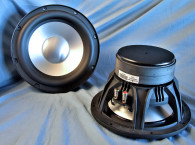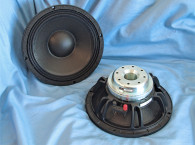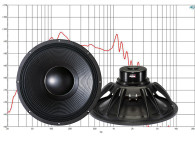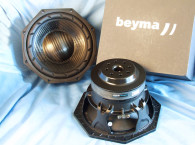

This month’s sample submission is in the upper range in terms of power handling with a continuous power handling rating of 3kW (1.6W nominal). This driver represents B&C Speakers’ next generation of pro sound subwoofers, which have very long voice coils and are available in 4Ω versions. Applications range from discreet PA subwoofers to three-way PA speakers.
Features for the B&C 15DS100-4 are like most high-performance pro sound drivers — rather substantial. Starting with the frame, the 15DS100 uses a proprietary 12-spoke (six twin spokes) cast aluminum frame incorporating six 4mm × 40mm rectangular vent holes in the area below the spider mounting shelf for enhanced voice coil cooling. This series of cooling vents allows air to move past the voice coil and across the front side of the neodymium motor assembly.
The cone assembly consists of a ribbed flat profile paper cone with a waterproof coating on the both sides of the cone along with a 6” diameter paper dust cap, likewise with a waterproof coating. Compliance is supplied by a three-roll pleated coated cloth surround, with the remaining compliance coming from a double silicone 6” diameter flat spider (damper). Tinsel leads are stitched into the spider for long-term stability.
The motor design on the 15DS100 driver utilizes an inside neodymium slug along with a T-shaped pole piece. The neodymium magnet motor was FEA designed using a 100mm (4”) diameter four-layer voice coil wound with round aluminum wire on a non-conducting glass fiber former. Motor parts, the return cup, and the front plate are coated with a black heat-emissive coating for improved cooling, with the cooling additionally enhanced by a 12mm diameter center vent and 10 11mm diameter peripheral vents. For distortion reduction, B&C Speakers has equipped this motor with an aluminum demodulation ring (shorting ring aka Faraday shield). Last, the voice coil is terminated to an injection-molded terminal block with color-coded chrome-plated push terminals.
I commenced testing the 15DS100 using the LinearX LMS analyzer and VIBox to create both voltage and admittance (current) curves. I clamped the driver to a rigid test fixture in free-air at 1V, 3V, 6V, 10V, 15V, 20V, 30V, and 40V allowing the voice coil to progressively heat up between sweeps. The 15DS100 driver remained more than sufficiently linear enough for LEAP 5 to curve fit at 40V level, and probably would have stayed linear up to at least 50V or 60V in free-air. This is no surprise given the 9mm Xmax of this 15” driver.
Following my established protocol for Test Bench testing, I no longer use a single added mass measurement and instead use the physically measured Mmd data (218.6 grams for the 15DS100). I post-processed the 16 550-point stepped sine wave sweeps for each 15DS100 sample and divided the voltage curves by the current curves to generate impedance curves, with the phase derived using the LMS calculation method. I imported the data, along with the accompanying voltage curves, to the LEAP 5 Enclosure Shop software.
Because the Thiele-Small (T-S) parameters provided by the majority of OEM manufacturers are generated using either the standard model or the LEAP 4 TSL model, I additionally created a LEAP 4 TSL parameter set using the 1V free-air curves. I selected the complete data set, the multiple voltage impedance curves for the LTD model, and the 1V impedance curve for the TSL model in the Transducer Model Derivation menu in LEAP 5 and created the parameters for the computer box simulations. Figure 1 shows the 1V free-air impedance curve. Table 1 compares the LEAP 5 LTD and TSL data and factory parameters for both of B&C Speakers 15DS100 samples.

LEAP 5 parameter calculation results for the 15DS100 were in close agreement with the published factory data, with a couple of minor exceptions. The first is that my Sd calculations include half the surround while B&C Speakers’ Sd was slightly less conservative. Also the published coil length and gap height dictate a 9.0mm Xmax, however, the B&C Speakers’ 13mm Xmax number is accounting for fringe-field effects, similar to the Xmax+15% figure that
I use, but more like Xmax+47% and is based on distortion output, not physical configuration.
Following my established protocol, I configured computer enclosure simulations using the LEAP LTD parameters for Sample 1. Two computer box simulations were programmed into LEAP 5—one the factory recommended vented box with a 4ft3 volume (15% fill material) tuned to 40Hz and a more compact vented alignment with a 3ft3 volume tuned to 46Hz, also simulated with 15% fiberglass damping material.
Figure 2 displays the SPL results for the 15DS100 in the two vented enclosures at 2.83V and at a voltage level sufficiently high enough to increase cone excursion to Xmax+15% (10.4mm for the 15DS100). This produced a F3 frequency of 35.5Hz (F6=33Hz) for the factory recommended enclosure and -3dB=41Hz (F6=38Hz) for the smaller vented simulation, indicating that the 15DS100 would still provide good low-frequency output in a more compact enclosure. Increasing the voltage input to the simulations until the maximum linear cone excursion limit (10.4mm by my criteria) was reached resulted in 123dB at 60V for the factory recommended box and 124dB for the same 60V input level for the smaller vented box.

Figure 3 shows the 2.83V group delay curves. Figure 4 shows the 60V excursion curves. Please note that the drivers start over excursing below 40Hz, so an appropriately steep high-pass filter will increase the undistorted output considerably.


Klippel analysis for the B&C 15” pro sound woofer (our DA2 analyzer is provided courtesy of Klippel GmbH) and performed by Pat Turnmire, of Redrock Acoustics (author of the SpeaD and RevSpeaD transducer development software). Testing produced the Bl(X), Kms(X), and Bl and Kms symmetry range plots given in Figures 5-8. The Bl(X) curve for the 15DS100 (Figure 5) is moderately broad but with some obvious offset, including being somewhat tilted. Looking at the Bl symmetry plot (Figure 6), this curve shows a 0.99mm coil-out offset at the 9.0mm physical Xmax position. The offset remains fairly constant in the 5mm to 10mm excursion range varying only about 0.6mm.


Figure 7 and Figure 8 give the Kms(X) and Kms symmetry range curves for the B&C Speakers 15DS100. The Kms(X) curve is also rather symmetrical in both directions accompanied by a very small amount of coil-out offset and tilt. Looking at the Kms symmetry range plot, the coil-out offset at the physical 9.0mm physical Xmax of the driver is 1.9mm.


Displacement limiting numbers calculated by the Klippel Analyzer for the B&C Speakers 15DS100 were XBl @ 70% Bl=11mm and for XC @ 50% Cms minimum was greater than 12.8mm, which means that for the 15DS100, the Bl is the most limiting factor for prescribed distortion level of 20% (the subwoofer criteria). Both of these numbers are beyond the physical 9mm Xmax for the 15DS100, so good performance for a subwoofer.
Figure 9 gives the inductance curves Le(X) for the 15DS100. Inductance will typically increase in the rear direction from the zero rest position as the voice coil covers more pole area, which is not what is happening here, but is typical of this type of neodymium motor that incorporates an aluminum demodulation (shorting) ring. The inductance swing from the rest position to Xmax out is a reasonably low 0.18mH, and 0.099 to Xmax in, which is really outstanding inductive performance for this powerful a neodymium motor.

Since the 15DS100 is a subwoofer, as usual, I do not perform and frequency response testing, or time/frequency measurements. However, Figure 10 does give the factory frequency response curve.

For the last remaining test, I employed the Listen, Inc. SoundCheck AudioConnect analyzer and SCM microphone. For the distortion measurement, I mounted the 15” driver rigidly in free-air, and set the SPL to 104dB at 1m (18.1V) using a pink noise stimulus, and then measured the distortion with the Listen’s microphone placed 10cm from the driver. This produced the distortion curves shown in Figure 11.

Looking at the objective data gathered on the 15DS100, this one as with all the transducers from B&C Speakers that we have been examined in Test Bench, looks to be a very well-engineered driver with a good set of performance trade-offs for a pro sound subwoofer that goes below 40Hz. For more information, visit www.bcspeakers.com. VC
This article was originally published in Voice Coil, October 2021







